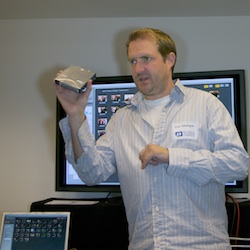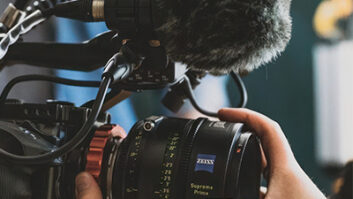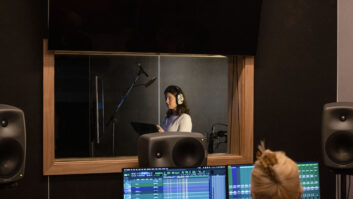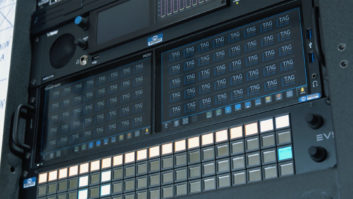
The world is changing. With cameras now producing data rather than videotape, the complex world of digital imaging logging, storage, transcoding and output emerges into the light. David Fox analyses a recent workshop designed to clarify some of the thorny issues involved.
Digital cameras produce huge amounts of data, which needs to be logged, copied, transcoded, displayed, output, and sent to an editor. The solid-state media that many cameras record to is too expensive to simply store on a shelf, as a tape might have been, so it needs to be copied off to another medium before it can be reused. All this takes time, effort and skill.
This is where the Digital Imaging Technician comes in, although exactly what a DIT does hasn’t yet been codified in a clear manner. To help clarify matters, the Guild of Television Cameramen recently held a ‘Keeping Track of the Data’ workshop at Pinewood Studios, led by DoP Dan Mulligan of Rogue Element Films (pictured).
In his role as GTC Standards Officer, he is currently working with other interested bodies, such as the Guild of British Camera Technicians, the broadcasting union BECTU and the British Society of Cinematographers to try to get some recognition for DITs and a grading path that fits within current pay structures.
DIT “has now become a broad brush term for many roles on set,” including image management, data management, quality control, applying look up tables (for viewing rushes), archiving and setting up the digital infrastructure. However, there is no training or qualification set for DITs.
“The DIT role has evolved without a true understanding of what the tasks entail. A lot of people on set claim they are DITs, but don’t do anything more than transfer files.” However, “the people in charge know less,” he said.
“Too often, all the responsibility of a £100,000 commercial may rest on the Red DIT, who is being paid less than a traditional film loader,” added experienced DIT Dan Gagatt. “There is a lot of confusion about what skill sets are needed for a DIT.”
Gagatt has worked extensively on set and in post, and takes the quality control aspects of his role seriously, checking rushes as soon as possible — rather than waiting to the end of the day.
“A DIT can cover the roles of five or six people. It’s a hell of a lot of responsibility for someone who is on £200 per day, if he’s lucky,” said Mulligan.
“It’s so expensive to re-shoot, you have to get it right. This is why there is a need for proper training.” Mulligan believes that the natural fit for a DIT on set is within the camera department. “The skills required for entry-level DIT staff is pretty straightforward” – a basic understanding of how a set works, “so a camera assistant could do it fairly easily.”
One problem is that a lot of DITs and DoPs don’t know much about the camera they are using, as each digital camera has its own features and settings. Mulligan has shot with just about every camera available, and has found that they all need different workflows. In the US, DITs are often expected to set up the camera for the DoP, because that is how DIT evolved there.
Making the work flow
For high-end work, the DIT would deal with uncompressed DPX files, recording to RAID drives (such as S.Two mags) at 1.2GB per minute, in 4:4:4, “which is as close as digital can get to film.” For high-budget productions such as Martin Scorcese’s current 3D movie Hugo Cabret, the data management team essentially has an on-set digital film lab.
At the lower end recording is probably to small portable drives — and probably attempting the difficult task of trying to judge picture quality on a laptop screen in less than ideal viewing conditions.
Since the advent of the Red One, in particular, it has been easy for someone to get a laptop, download the free software from Red, and call themselves a DIT. “It’s causing problems for the more experienced people and for productions due to a lack of experience,” said Gagatt.
One problem is that manufacturers give little support to DITs. “A lot of people are relying on finding the answers on the internet,” he added.
Mulligan has had one supposed DIT come up to him and say: “I’ve worked on a job with Dan Mulligan,” and he’d never met him before. “The person was just regurgitating someone else’s story from an internet forum.” This is why he is so keen to get recognised training for DITs, once it’s possible to agree on what a DIT is and does. “At the moment it’s like the Wild West: who’s the cheapest person out there…”
“The disciplines have been there for years, such as clapper loader,” said Lagatt, “but when it comes to the DIT role you’d think it would be common sense to talk to the experts early on to get advice and set up the correct workflows in advance. But that might cost money so productions end up spending more by not taking advice.
“It’s very rare that you get a production that will have a meeting about it beforehand,” said Mulligan. “The film workflow is well known, but the digital workflow is still in a state of flux, because everyone has too many options.”
Because digital doesn’t have film stock costs, it is easy to over shoot. Gagatt worked on a five-day commercial that turned over the data more quickly than it was possible to recycle the media (five drives per Red and two Reds), although he had two archive systems plus a backup.
The infrastructure needed to backup data on location varies. Cabling can range from FireWire 800 (at the low end) to Ethernet or Fibre Channel. An uncompressed 4:4:4 production may back up to an S.Two Take2 workstation, with archive to LTO tapes (although 30 minutes of material can take 90 minutes).
Each LTO tape has a unique barcode and you can’t write to the tape until the barcode has been added. An LTO 3 tape can hold 400GB, which makes it particularly suitable for archiving from a 320GB S.Two mag.
“You don’t want to have more than one mag on a tape for reliable reference,” said Mulligan. He often records on to a nanoFlash or P2 card at the same time for offline copies – as any camera that has HD-SDI can record to either. Some TV productions use P2 as their master copy – the BBC drama Ashes To Ashes shot on an Arri D21, recorded to P2. However, for high-end work, especially where there will be a lot of visual effects, uncompressed is becoming more popular.
“Getting things talking to each other is one of the most difficult issues. The computer may see the hard drive, but the software may not.” On one shoot, the DPX files were recorded 4:2:2 YUV, which Mulligan could see at his facility, but the post house couldn’t. “Once software starts driving all these environments, things will start failing more often.” Then “it’s your fault for recording in a format they can’t use, but the post house hasn’t thought to come on set and test,” he said.
You can get a situation where a production upgrades camera firmware during a shoot — which he thinks is nuts — but the person told to do the upgrade gets blamed when something goes wrong.
Seeing Red
“Software is the weakest link. It often doesn’t work properly or makes the workflow more complicated than it should be,” said Mulligan. “Digital can be a very efficient way of working, but everyone needs to be in the same place,” where everyone has a defined role and works together. “Of course, some of the software issues may be people issues, as they have to learn a new program.”
Many big shoots are relying on beta software from Red, which can go wrong. “Red is a very capable system. It delivers very good HD pictures, but is not entirely stable, even now,” added Mulligan.
The Red Raw files are computationally intensive, because they need to go through a deBayer (although there are accelerator cards available). The R3D data manager software can check the data as it copies, but slows the process down. “Most newcomers to Red, and many DITs, just drag and drop,” which doesn’t check anything. Because Red was so unreliable in the early days, Gagatt is “slightly paranoid about checking it.” On fast turnaround jobs it requires more than a laptop – he has an eight-core MacPro he uses on these.
He has lost data on several occasions, generally due to software errors, although he’s usually managed to retrieve it. “If you do a shoot on Red, try to stick to solid state media on the camera, as disk drives can get as roughly treated as the camera does – and you don’t know who has hired it before you.”
Another problem for the DIT is being presented with formats for which you aren’t prepared. Gagatt has been on a Red production where he then also had to deal with “making of” material being shot on an EX3 and extra footage from a Canon EOS 7D (which took longer to transcode).
It’s not just high-end productions that need a DIT. “People shooting P2; can they do all this on their own: copying rushes, logging, sending them back, etc.? If you shoot every hour of the day, how do you do the DIT role as an individual cameraman? We need the return of the camera assistant to look after file-based cameras,” said Mulligan.
“Digital’s not difficult. People make is seem difficult because they don’t know enough and think it is more complicated than it is.”
He has found it is unwise to record hours of video to a single card or drive, because that will require hours to ingest. “It is better to shoot 20 minute chunks and have them copied, etc., during the day as you shoot.”
Mulligan does a lot of testing of different workflows and what is the best equipment to use, but he has a rental company so he has access to all of the equipment. For P2 cards, for example, he recommends one copy for archive, one for editorial and, preferably, a third for backup.
On Display
“Fully calibrated viewing environments are essential,” but where you are looking at the pictures makes a big difference – a forest at noon is going to be very different from a cinema. Mulligan recommends using a FilmLight Truelight colour management system, which can apply calibrated LUTs to images on set. Hugo Cabret has a fully calibrated viewing environment next to the set, with a Christie 2k projector, with 3D LUTs, Baselight colour grading, etc., which can be used to do 80% of the grading during shooting — “but that is rare”.
He recommends that productions don’t allow the equipment they have to dictate the workflow, but to decide how they want to shoot then get the right equipment. “Keep it simple and scale appropriately. Don’t limit yourself to one laptop when you need four, and don’t try to do colour grading on a laptop. You are downloading and archiving the negative, which is why it’s so important that the DIT protects the pictures from going missing,” said Mulligan.
“Producers need to recognise how important DITs are to their shoots.” One production he worked on lost a day’s shooting because it recorded the monitor output from the camera (complete with frames and data) rather than the clean output.
“In the US, a DIT is treated as part of the team, and a good one is one of the first names you call. But here it is an afterthought. Most of the good DITs I know come from the camera team. They are part of the process — but many DITs are picked purely on cost.”
Gagatt feels that DITs should at least have worked at the level of focus puller, so that they understand optics. “The more you know, the better; but do people really care? No they don’t,” he said.







